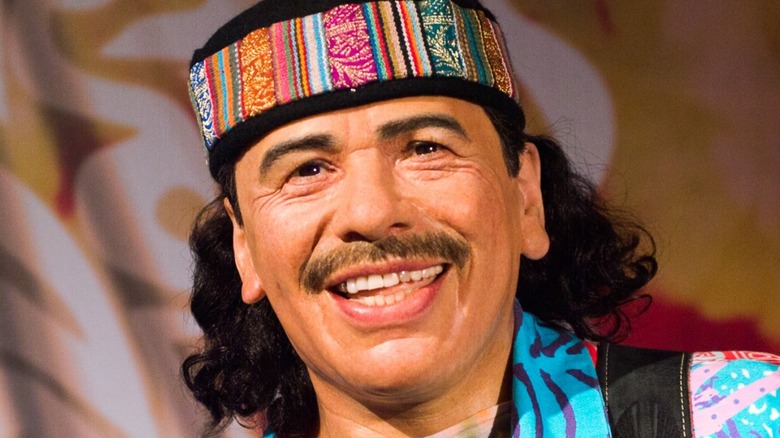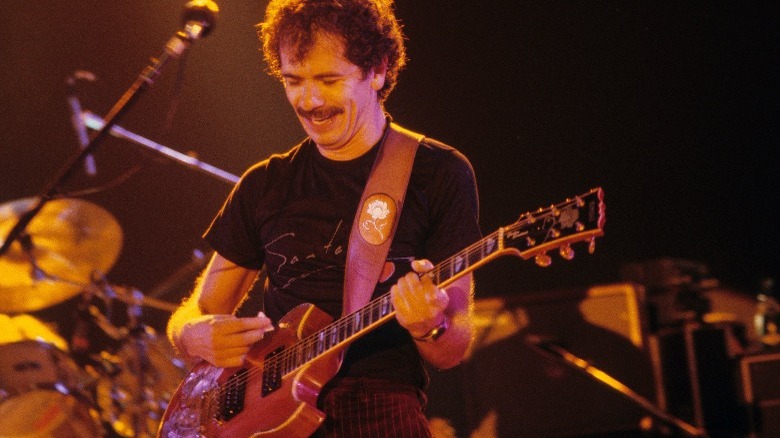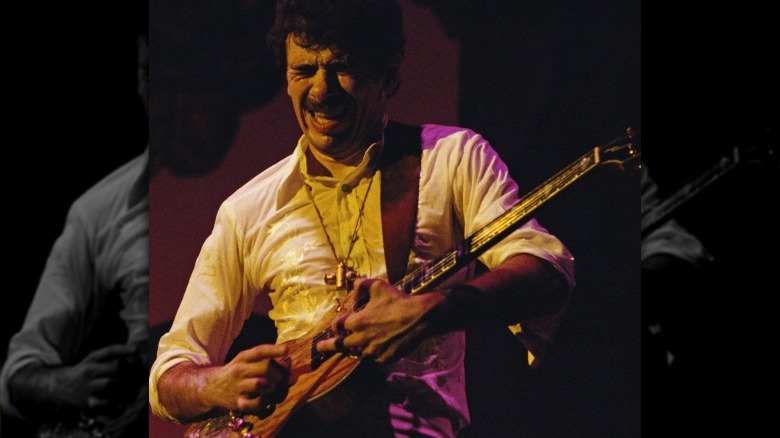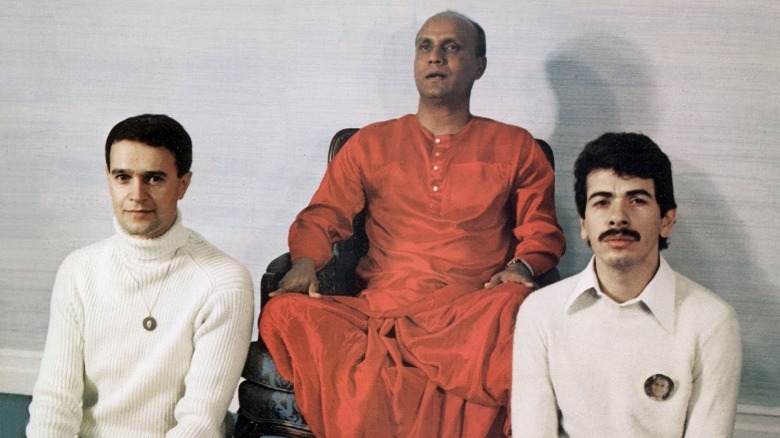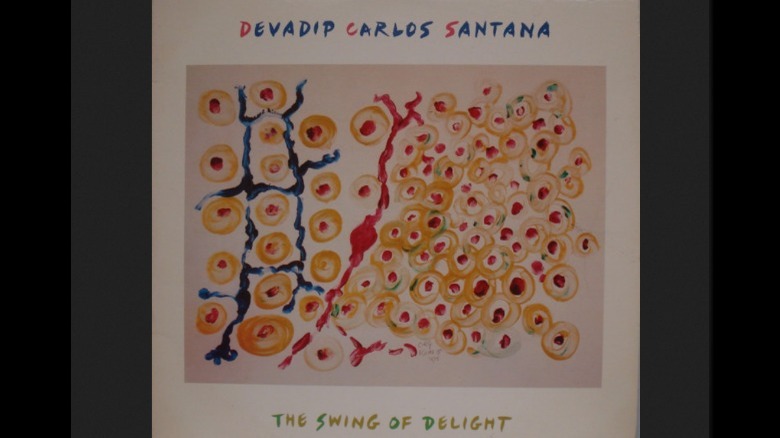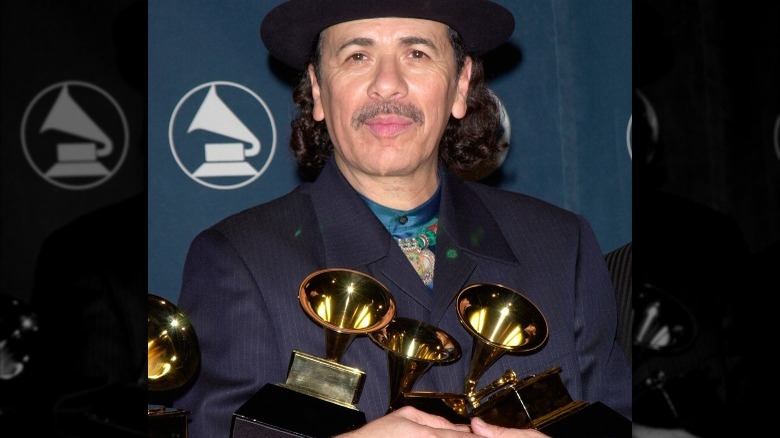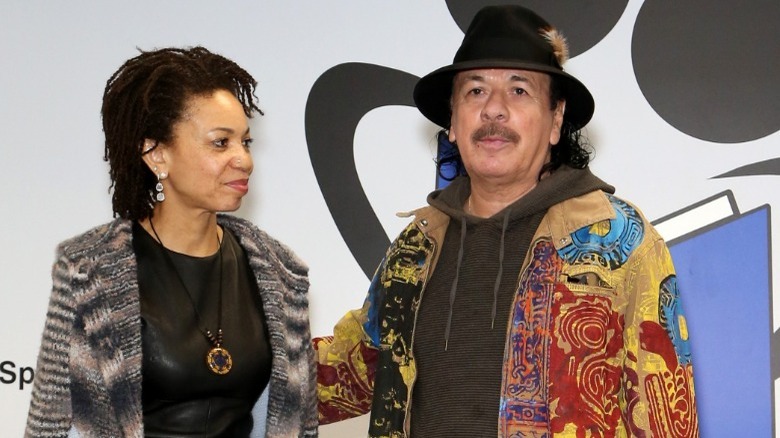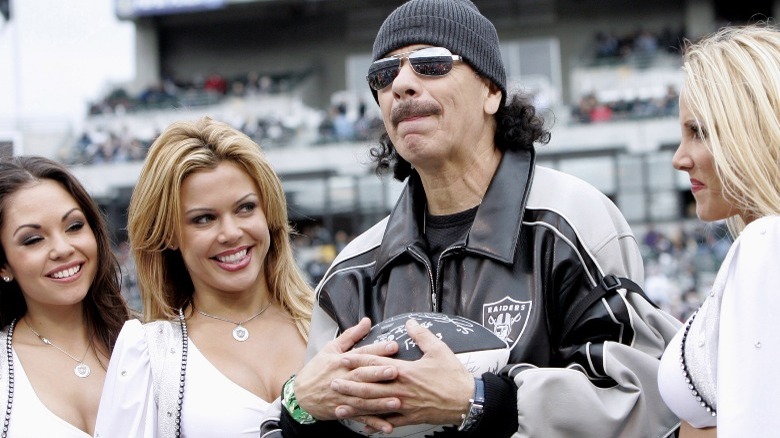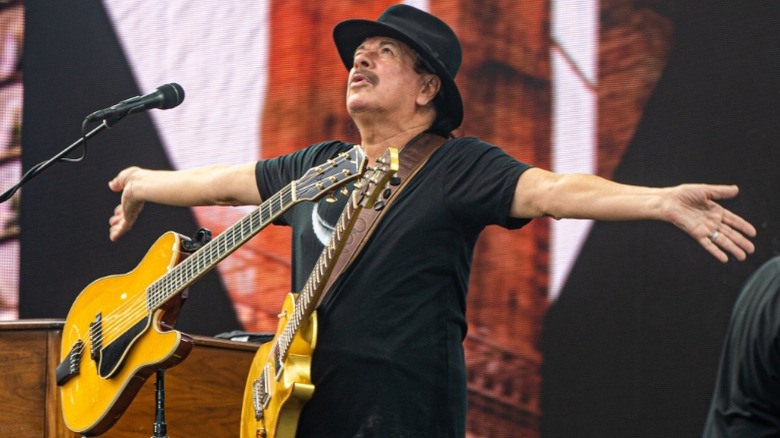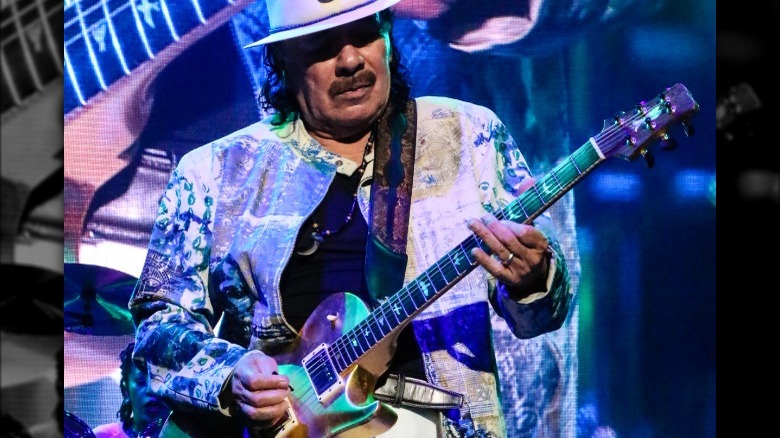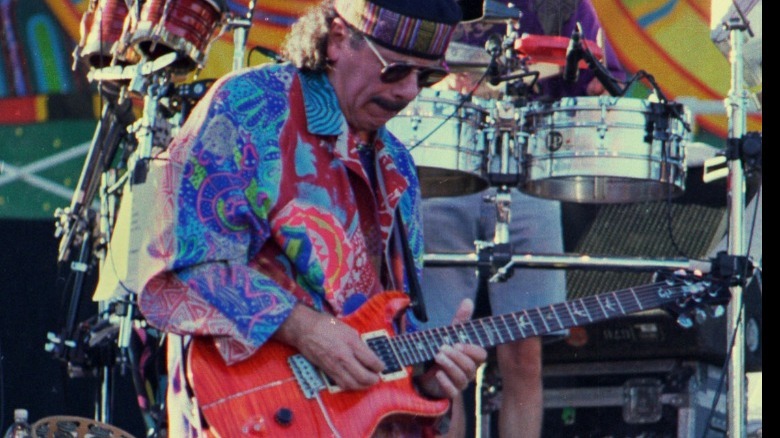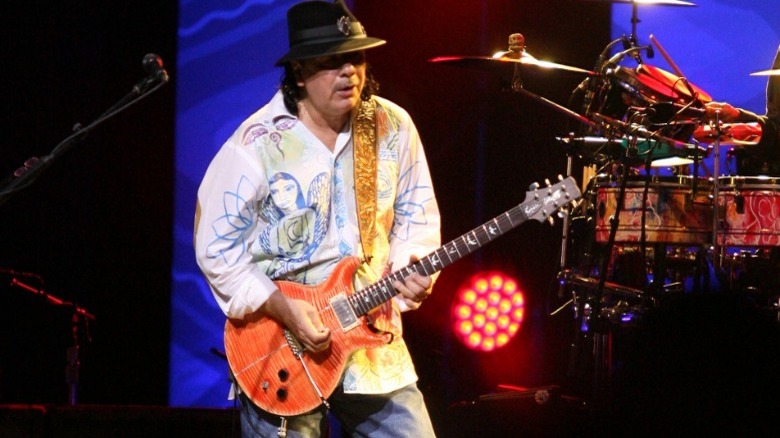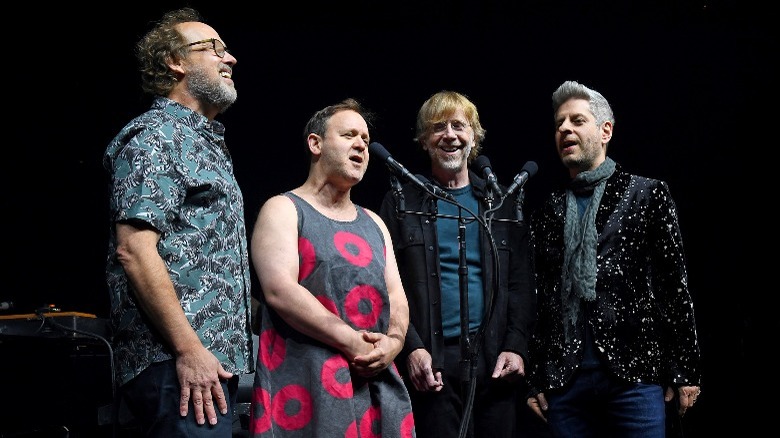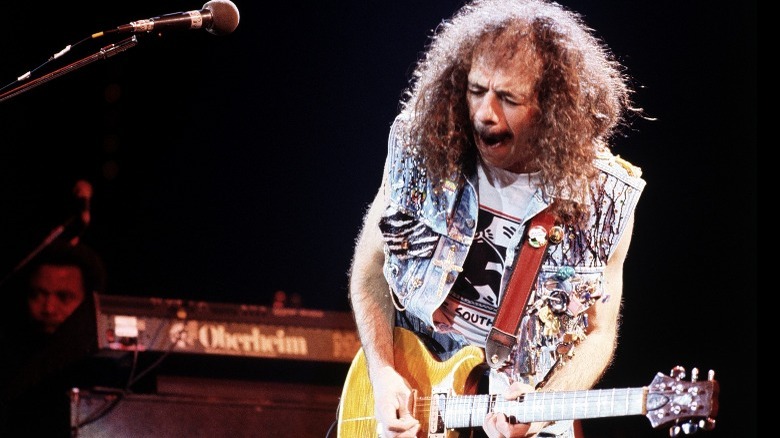The Untold Truth Of Carlos Santana
Carlos Santana is one of the most well-known and respected artists in music history. He is renowned for his ability to seamlessly incorporate many different styles into his compositions, mixing in elements from Latin music, jazz, and blues (per Biography). He formed his band, Santana, in the 1960s, and they saw sustained success through the 1970s and 1980s. Commercially, the band faded as the 1980s wore on, and Carlos started to release solo albums in addition to Santana band material.
Santana started to reemerge as a fixture of popular music in the late 1990s, fueled by the release of their album "Supernatural." The album featured covers with several prominent stars, like Cee Lo Green, Dave Matthews, and Rob Thomas — the latter of whom's collaboration on the song "Smooth" became a No. 1 hit single. In 2009, at the Billboard Latin Music Awards, Santana was honored with their Lifetime Achievement Award, a testament to his incredible success and contributions to the Latin music community.
Carlos has continued to release both solo records and albums with Santana. In 2019, he collaborated with artists Tyga and YG on the single "Mamacita." Two years later, in 2021, the band released "Blessings and Miracles," which featured Chick Corea in one of his last appearances before his death (via Louder).
Though he has been in the limelight for nearly 60 years, there is still a lot even big fans do not know about him. This is the untold truth of Santana.
He grew up in a musical household
Since he was just a child, Carlos Santana's life has been surrounded by music. He was born in Autlán de Navarro, Jalisco, Mexico, on July 20, 1947, to musical couple José and Josefina Santana (per Marc Shapiro in "Carlos Santana: Back on Top"). José was a member of a local band, Los Cardinales, that was the "focal point" of their hometown. Los Cardinales played all kinds of special occasions, from weddings and baptisms to political events and ceremonies.
Carlos was fascinated by everything about the bands that played in his village. He enjoyed their music as well as their traditional troubadour costumes and garb. However, it was his father's violin playing that made the biggest impression on the young Santana. He recalled seeing how moved people were by his father's musicianship, and it made him realize the power of music.
To make money to support his struggling family, José was on the road a lot when Carlos was a child. Yet, he was able to instill a deep appreciation for music amongst his children, and he even tried to teach Carlos the violin. After seven years, Carlos finally gave up; he hated everything about it. Eventually, though, Carlos became interested in the electric guitar after seeing guitarist Xavier Batiz perform in Tijuana. His mother had encouraged him to explore other kinds of non-traditional music, and his previous experience on violin made him a natural on guitar.
He was abused as a child
One of the most tragic details about the life of Carlos Santana is his little-known story of abuse as a child. According to his autobiography, "The Universal Tone: Bringing My Sound to Light," while attending one of his father's concerts as a kid, an older American man started to befriend him. He would buy Santana gifts and spend time with him during his father's performances, and even Santana's parents started to come around to trusting the foreign tourist.
One afternoon, the American offered to smuggle Santana across the border into San Diego, and the impressionable boy agreed. It was then that things turned, and the man started to sexually abuse the young Santana. The experience was horrifying for him, and he felt a mixture of "confusion, shame, and guilt" over the encounters. They happened repeatedly, and Santana became ashamed of the continued abuse. His mother confronted him about it in front of his entire family, further shaming and traumatizing Santana into believing wrongly that he was the one responsible. Eventually, the man was involved in a serious car crash and became disabled, and Santana never saw him again. He sought professional help in the 1990s and publicly talked about the abuse in 2000, during an interview with Rolling Stone.
If you or anyone you know has been a victim of sexual assault, help is available. Visit the Rape, Abuse & Incest National Network website or contact RAINN's National Helpline at 1-800-656-HOPE (4673).
He was a follower of spiritual guru Sri Chinmoy
One of the lesser-known aspects of Carlos Santana's life is his period of study under spiritual guru Sri Chinmoy. In 1972, Santana first learned about Chinmoy when he saw a picture of him that belonged to fellow guitarist Larry Coryell (via Santana's autobiography "The Universal Tone"). He "could feel the intensity from the man just through the picture," and it was in October of the following year that he was formally introduced to the guru by guitarist John McLaughlin (all three pictured above).
Santana instantly felt a connection with Chinmoy, and he shaved his beard and cut his hair upon his instruction. He recalled his time with Sri as "more rewarding than all the things the world was offering," and referred to it as a "spiritual boot camp."
However, within a few years things had started to turn sour for Santana and Chinmoy. By 1977, Santana began to have second thoughts about how Chinmoy treated some of his other followers, and was feeling that "everything that used to be honey was turning to vinegar." Both McLaughlin and Coryell had departed Chinmoy's guidance by then, and Santana was done, too. Carlos went on tour with Santana and told his wife, Deborah Santana, who was also under Chinmoy's guidance, that he was through. Four years later, Deborah also left Chinmoy, but Santana still holds a place for the guru in his heart — though Chinmoy did get a little vindictive upon their final split, reportedly telling his other students to stop associating with Santana.
Santana released two solo albums under a different name
While Carlos Santana was following spiritual guru Sri Chinmoy, he did more than just shave his beard, cut his hair, and alter his lifestyle. According to his autobiography, "The Universal Tone," he even briefly changed his name to one that Chinmoy had given him. In 1973, Chinmoy gave both him and his wife Deborah Santana new "spiritual names." Carlos was to be known as Devadip, which meant "lamp of God" and "eye of God," and Deborah started going by Urmila, which meant "light of the supreme."
While Carlos continued to release material with his band under the moniker Santana, his solo releases started to feature his new name instead. In 1979, he released his first solo album, "Oneness: Silver Dreams – Golden Reality," under the name Devadip Carlos Santana. He had stopped actively working with Chinmoy in 1977, but he still used the name the guru gave him on the album. In 1980, Santana released "The Swing of Delight," also under the name Devadip, and it featured the four supporting members of Miles Davis' Second Great Quintet from the late 1960s.
He released "Delight" as an homage to Chinmoy, to thank him for the help he had given the couple. Chinmoy was even responsible for creating the album's cover art. Yet, when they both stopped seeing Chinmoy in 1981, the guru took back their spiritual names, and they went back to being just Carlos and Deborah Santana.
He tied the record for winning the most Grammys in one night
Being one of the most accomplished and diverse artists in modern music, it does not come as much of a surprise that Carlos Santana has won at least a few Grammys. Still, many fans are a bit amazed when they find out not only has he won 10 Grammys, but he even won eight on the same night — tying a Grammy record (per Rolling Stone). He won his first award in 1987 for his solo album "Blues for Salvador," and though he had been nominated for others, he had lost.
Yet, it was at the 42nd Grammy Awards in 2000 that Santana truly made his mark. He won eight Grammys that night, several of which were for his album "Supernatural" that had been released the previous year. "Supernatural" featured a collaboration with Rob Thomas on the song "Smooth," which became a massive international hit, and the two performed the song live at the awards show.
He recalled being surprised that he kept winning the awards, and after a few wins he stopped trying to give acceptance speeches. He would simply say "thank you" and walk away with the award, though he did talk a little longer for his speeches related to "Supernatural." He still remembers the night fondly, and when he looks at his awards, he remembers many of the great times he had with former members and managers of the band.
He proposed to his wife after she played a drum solo onstage
Carlos Santana has always been part of a big family. When he was growing up he had six siblings in his household, four sisters and two brothers, and they shared just two bedrooms between them (via Rolling Stone). As an adult, Santana has three of his own children, Salvador, Stella, and Angelica, and he named his 1987 album "Blues for Salvador" after his son (per Marc Shapiro in "Carlos Santana").
He married his first wife, Deborah, in 1973, and they were together for 34 years until they divorced in 2007 (via Biography). Three years later, in December 2010, Carlos married Cindy Blackman (pictured above) after they had gotten engaged earlier that summer. She was the drummer in Santana, and they were playing a show in Chicago when he popped the question. They were just four songs into their set, and Blackman had just finished a drum solo when Carlos proposed onstage. The crowd reportedly cheered them on as the couple shared an onstage kiss after she accepted his proposal (per CBS). Santana and Blackman currently live together in Las Vegas.
He is a proud humanitarian
Carlos Santana has always been known for his generosity and philanthropy. Yet, most fans are blown away when they realize just how much, and to how many causes, he has contributed. In 1998, he established his own charity, the Milagro Foundation, to "support under-resourced children and youth in the areas of arts, education and health." The charity is based out of the San Francisco area, but works with children around the world on health issues.
In 2017, after a string of hugely destructive earthquakes in Mexico, Santana donated $100,000 through Milagro to the Save the Children foundation to support the families in recovery (via Save the Children). Over 300 people had died and 25,000 homes had been destroyed, leaving thousands displaced. In 2020, just after the COVID-19 pandemic started, Santana and his wife Cindy Blackman partnered with several charities to raise money by recording a cover of John Lennon's classic song "Imagine" (per Rolling Stone).
Later in 2020, Santana created the Carlos Santana Coffee Company, which is also connected to Milagro. According to his website, a portion of every sale goes back to the foundation to support underprivileged youth.
Carlos Santana is a naturalized U.S. citizen
In 1961, just after Carlos Santana had picked up a guitar and started playing with local groups in Tijuana, his mom gave him an unfortunate surprise. Seeing the increased economic prospects across the border, and fearing for the future of her children in Mexico, his mother decided to move the family to San Francisco, California (via Marc Shapiro in "Carlos Santana"). His father was already working there and making a good living, but when Santana arrived he had trouble fitting in with the other kids.
He was used to hanging with the much older, and much different, bar crowd in Tijuana, and it was quite a shock for him to start attending a junior high school with kids his own age. Getting homesick, he convinced his mother to allow him to go back to Tijuana, but that was only temporary, as the family soon came to get him and made him live with them in the States.
He ended up attending Mission High School in San Francisco, and after graduating in 1965 he became a naturalized American citizen (per the Pacific Coast Immigration Museum). He still identifies with his roots in Tijuana, and feels a connection when he travels to other places of similar socioeconomic status.
He was playing guitar for tourists at age 11
When he was growing up, Carlos Santana's family struggled immensely with poverty. Though he was born in Autlán de Navarro, Jalisco, Mexico, his family moved to Tijuana in Baja California when he was just 7 years old (via Rolling Stone). His parents felt that Tijuana would be a more lucrative place for his father to make money playing music, but the move was a "shock" to the young Santana.
To make matters more frustrating, as soon as they got there, his father put him and his brother to work to help support the family. They would spend their time shining shoes or selling gum on the streets — pretty much the only jobs a couple of young adolescents could get. By the time he was just 11 years old, he was playing music with his father on the same streets (via CBS). They would perform for passing American tourists, charging 50 cents a song, but after a few years Santana got tired of performing in "the sleaziest parts of town," and soon moved on.
He has his own cannabis company
A lifelong user of cannabis, in 2020 Carlos Santana actually created his own brand to be sold in stores. It is called Mirayo, which means "my ray" and "my lightning" in Santana's native language of Spanish (via Forbes). It actually runs in his family, as his mother used to make herself ointments for pain containing extracts from the plant. He uses cannabis to obtain a higher consciousness, and he is a firm believer in its ability to help social and communal ills.
Being a philanthropist, Santana is not keeping the profits, saying "I don't mind pledging all of it to help my brothers and sisters" in the Mexican and Native American community. He called Mirayo a "blessing" and advocated for the spiritual use of cannabis. The packaging is full of vibrant colors and Hispanic designs, bringing together several different elements of Santana's musical heritage.
Even getting into his mid-'70s, Santana is still a frequent user of the plant. During an interview with cannabis website Weedmaps, he claimed that he was a regular smoker, though he was starting to branch out into using edible products, too.
He has a chain of restaurants in California
Though he opened up the first in 2007, most fans of Carlos Santana do not realize that he actually has a chain of restaurants throughout the U.S. According to his website, the chain is called Maria Maria, and he opened up his first in Walnut Creek, California. It is described as serving authentic pan-Mexican cuisine, and it is a collaboration between Santana and award-winning Chef Roberto Santibañez. Like many of his other ventures, all of the profits from Maria Maria go to Santana's Milagro charity foundation (via the SF Gate).
When their Danville, California, location opened, the walls were adorned with psychedelic art, and the lighting sconces were designed to mimic the distinctive and iconic shape of Santana's guitars. The menu is composed of traditional Mexican dishes, like meat tacos and seafood guacamole, but "with a contemporary spin." They had five restaurants at their peak in 2010, including three in California, but several have closed in the last few years, including their Danville (per Danville San Ramon) and Austin, Texas, locations (via Eater: Austin).
Carlos Santana has a special relationship with the band Phish
If there is one thing that Carlos Santana is known for, it is his many collaborations with other musicians. He first collaborated with John McLaughlin in the early '70s on "Love, Devotion, and Surrender," which was somewhat of an homage to John Coltrane (via All Music). Since then, he has worked with musicians like Rob Thomas, Michelle Branch, and John Lee Hooker, on some of the biggest hits of his career.
One of his more unexpected collaborations, though, is with the jam band Phish (pictured above). It started in July 1992, when Phish performed as the opening act for Santana over a six-week tour. Not only did he invite them to perform during Santana's set each night, but he even joined them for a concert in Phish's home state of Vermont (per Parke Puterbaugh in "Phish: The Biography"). Santana mentored the young band during their time together, teaching them some of the finer points of connecting with their audience.
Since the 1992 tour ended, Santana and Phish have connected onstage a few more times. Phish opened for them again in Europe in 1996, and members of Phish appeared with Santana in both 1999 and 2003 (via JamBase).
He does not believe in organized religion
Though he has spent most of his life in the public eye due to his early success, religion is not a topic that Carlos Santana generally broaches during his interviews, which is why it might surprise fans to know his thoughts on organized religion. During a 2014 interview with Rolling Stone, Santana stated that he did not consider himself a member of any organized religion. Instead, he said "my faith would be holy willingness, divine confidence, perfect perception, sacred certainty, spiritual knowing, heavenly awareness, state of grace and illuminating thoughts."
He dislikes that many organized religions have an inherent fear of God within them. He equated Bob Marley's famous lyric "Emancipate yourself from mental slavery" with being able to find self-confidence and self-worth within one's self, and that, to Santana, is the true meaning of religion. That is not to say that Santana does not believe in a higher power, and he consistently refers to his love for God, but he does not define himself by a religion.
